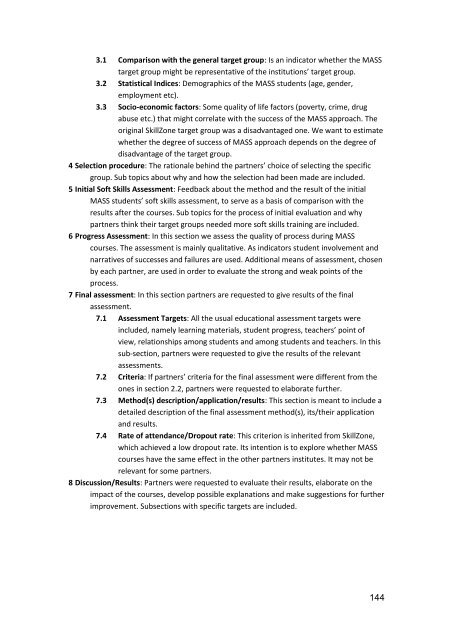Teaching and Assessing Soft Skills - MASS - Measuring and ...
Teaching and Assessing Soft Skills - MASS - Measuring and ...
Teaching and Assessing Soft Skills - MASS - Measuring and ...
You also want an ePaper? Increase the reach of your titles
YUMPU automatically turns print PDFs into web optimized ePapers that Google loves.
3.1 Comparison with the general target group: Is an indicator whether the <strong>MASS</strong><br />
target group might be representative of the institutions’ target group.<br />
3.2 Statistical Indices: Demographics of the <strong>MASS</strong> students (age, gender,<br />
employment etc).<br />
3.3 Socio-economic factors: Some quality of life factors (poverty, crime, drug<br />
abuse etc.) that might correlate with the success of the <strong>MASS</strong> approach. The<br />
original SkillZone target group was a disadvantaged one. We want to estimate<br />
whether the degree of success of <strong>MASS</strong> approach depends on the degree of<br />
disadvantage of the target group.<br />
4 Selection procedure: The rationale behind the partners’ choice of selecting the specific<br />
group. Sub topics about why <strong>and</strong> how the selection had been made are included.<br />
5 Initial <strong>Soft</strong> <strong>Skills</strong> Assessment: Feedback about the method <strong>and</strong> the result of the initial<br />
<strong>MASS</strong> students’ soft skills assessment, to serve as a basis of comparison with the<br />
results after the courses. Sub topics for the process of initial evaluation <strong>and</strong> why<br />
partners think their target groups needed more soft skills training are included.<br />
6 Progress Assessment: In this section we assess the quality of process during <strong>MASS</strong><br />
courses. The assessment is mainly qualitative. As indicators student involvement <strong>and</strong><br />
narratives of successes <strong>and</strong> failures are used. Additional means of assessment, chosen<br />
by each partner, are used in order to evaluate the strong <strong>and</strong> weak points of the<br />
process.<br />
7 Final assessment: In this section partners are requested to give results of the final<br />
assessment.<br />
7.1 Assessment Targets: All the usual educational assessment targets were<br />
included, namely learning materials, student progress, teachers’ point of<br />
view, relationships among students <strong>and</strong> among students <strong>and</strong> teachers. In this<br />
sub-section, partners were requested to give the results of the relevant<br />
assessments.<br />
7.2 Criteria: If partners’ criteria for the final assessment were different from the<br />
ones in section 2.2, partners were requested to elaborate further.<br />
7.3 Method(s) description/application/results: This section is meant to include a<br />
detailed description of the final assessment method(s), its/their application<br />
<strong>and</strong> results.<br />
7.4 Rate of attendance/Dropout rate: This criterion is inherited from SkillZone,<br />
which achieved a low dropout rate. Its intention is to explore whether <strong>MASS</strong><br />
courses have the same effect in the other partners institutes. It may not be<br />
relevant for some partners.<br />
8 Discussion/Results: Partners were requested to evaluate their results, elaborate on the<br />
impact of the courses, develop possible explanations <strong>and</strong> make suggestions for further<br />
improvement. Subsections with specific targets are included.<br />
144





